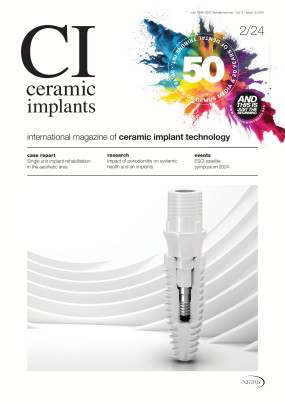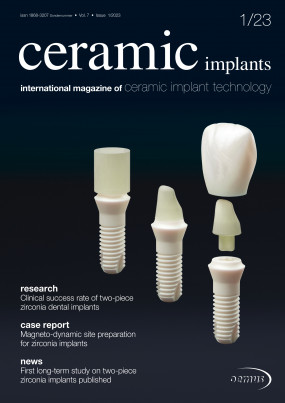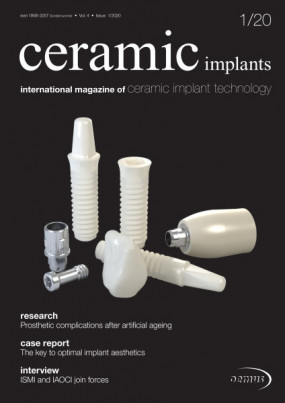Inhaltsverzeichnis
3
The connection between oral and systemi c health is no longer theoretical—it is undeniable. The loss of the oral periodontal and peri-implant barrier has been linked to endo- thelial dysfunction, cardiovascular disease, altered glucose regulation, immune sensitisation, and even neuroinflammatory mechanisms associated with Alzheimer’s disease. As our understanding deepens, the mouth can no longer be viewed as an isolated system. It is a central immunological gateway with profound effects on whole-body health.
6
Two-piece ceramic implant in the maxillary anterior region—a case report from the practice
Dr Florian Schnaith, Germany
The rehabilitation of patients with the aid of implants is becoming increasingly popular in dental practice. In the situations of gaps in the anterior region, implants are preferable to conventional bridge therapy, especially from an aesthetic point of view. Titanium implants have established as a standard due to good data and many years of successful use. Nevertheless, the use of ceramic implants in dental practice is teadily increasing. The following case report intends to demonstrate the advantages of this material and its manageability in two-part architecture following a clear indication.
14
A female patient presented at our practice for holistic treatment after learning from our website about the possible connections between chronic and acute illnesses and dental health. She complained of digestive issues such as bloating and diarrhoea. Additionally, her sleep was not restful; it was superficial and restless. She also had complaints related to her liver, circulation, nerves, and hearing (tinnitus).
22
Immediate zirconia implant placement—Connective tissue grafting in the aesthetic zone: A case-based narrative review
Dr Fabian Schick, Germany
The replacement of compromised anterior teeth in young patients with a high smile line presents a unique combination of functional, biological and aesthetic challenges. Thin gingival biotypes, a history of chronic infection and high aesthetic demands often complicate treatment planning and require protocols that minimise tissue trauma while maximising long-term peri-implant stability.
28
Biological screening before implant placement—Evaluating immunity and inflammation for predictable outcome
Dr Saurabh Gupta BDS MDS, India
Implant dentistry has evolved from a primarily mechan- ical endeavour into a biologically nuanced intervention that demands careful consideration of systemic health. Increasingly, evidence reveals that immunological readiness and subclinical inflammation are key predictors of successful osseointegration and longterm implant stability.1,2,5,7
31
Under the theme “Facts of Ceramic Implants Part III,” the European Society for Ceramic Implantology (ESCI) hosted the European Congress for Ceramic Implantology for the third time, held from 25 to 27 September 2025, in Horgen/Zurich, Switzerland.
34
A global experience that marked a turning point in biological implantology—Ceramic Implant Summit 2025—Buenos Aires
Author
On 24 and 25 October 2025, Buenos Aires became the world capital of ceramic implantology with the Ceramic Implant Summit—Z7 & ZiNova Global Experience, an international gathering that brought together more than 20 renowned experts and hundreds of professionals who attended both in person and via live stream from around the world.
36
EACim strengthens global presence of zirconia implantology at EAO and ADF congresses
EACim/Timo Krause
The European Academy of Ceramic Implantology (EACim) successfully asserted its position as a leader in the field during the prestigious annual congress of the EAO (European Association of Osseointegration). As one of the premier events in global dental implantology, the congress provided the ideal platform for the academy to engage with an international audience of specialists.
38
Kreuzlingen, October 2025—The 5th Annual Joint Congress for Ceramic Implantology (JCCI) convened in Kreuzlingen this past October, reaffirming its status as a premier global forum for biological dentistry. Set against the autumnal beauty of Lake Constance, the event successfully merged high-level scientific discourse with the professional expertise that has become the hallmark of this annual gathering.






















